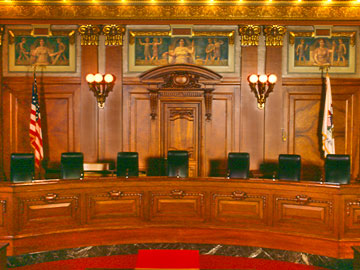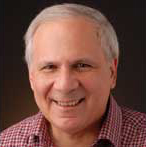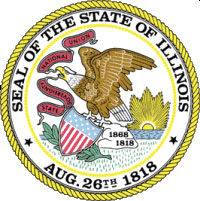Anthony Porter - The Post-Trial Period
Appealing the Conviction and Death Sentence
Direct Appeal
-
roles)) {
// user is not associated with role, redirect to signup page
?>
- Definitions of Key Terms
- Anthony Porter Timeline
- The Capital Appeals Process
- People v. Porter (1986)
- Porter v. Illinois (1986)
- People v. Porter (1995)
- Porter v. Gramley (1997)
- Please register or login for free access to our collection of supplementary materials.

In February 1986, the Illinois Supreme Court (pictured above) denied Porter's direct appeal, 4-3. The issue was the impartiality of the juror who had attended the same church as the female victim's mother. The majority concluded that since the juror in question was not aware of the relationship until after the trial began, it was unlikely the relationship was close or affected her decision. The dissenting judges commented that the exchange between the trial judge and juror lasted just a few seconds and was inadequate. One dissenting judge commented that the conviction should be vacated because the majority had no basis for speculating on the closeness of the relationship.
Subsequent Post-Conviction Proceedings
In October 1986, Porter filed a petition for writ of certiorari in the U.S. Supreme Court, which was denied by a 7-2 vote. Justices Marshall and Brennan wrote in their dissent that Porter "should not bear the burden of showing actual prejudice when the probability of bias is substantial."
In 1995, Porter filed a petition for post-conviction relief on the ground that he had been denied effective representation because his lawyer, Akim Gursel, had failed to call witnesses who would have testified about other suspects. One witness, Joyce Haywood, would have testified that the victims had gone to the park with Alstory Simon and Inez Jackson, which would have been corroborated by the victims' mothers and Marilyn Green's sister, Christina Green. Another witness, Ricky Young, would have testified that Jerry Hillard had been selling drugs for Simon, and that Hillard and Simon had been in a dispute over drug money. The Illinois Supreme Court affirmed the judge's decision to deny relief, holding this evidence should not be considered because Porter's appellate lawyer had not raised the issue of ineffective assistance of trial counsel on direct appeal.
In 1997, Porter's petition for a federal writ of habeas corpus was unanimously denied by the U.S. Court of Appeals for the Seventh Circuit, which concluded that Porter's allegations regarding his counsel's performance did not create a reasonable probability of a different outcome, as required by the 1984 decision of the U.S. Supreme Court in Strickland v. Washington. After the U.S. Supreme Court denied Porter's second petition for writ of certiorari early in 1998, his execution date was set for September 23, 1998.
At this point, Chicago lawyer Daniel Sanders volunteered to take on Porter's case. Four other pro bono lawyers joined Sanders in challenging the imminent execution. Sanders had Porter's IQ tested. His test result, 51, indicated he was mentally retarded. Although at that time it was still legal to execute a "mentally retarded" defendant (now referred to as a defendant with an "intellectual disability"), Porter's legal team argued that his diminished mental capacity rendered him incapable of understanding his punishment and he therefore could not be executed.
Stay of Execution
Fifty hours from execution, Porter was granted a stay by the Illinois Supreme Court out of their concern about Porter's very low IQ test score. The court was not confident Porter could comprehend what was about to happen to him. The stay was granted to provide time to explore Porter's mental capacity.
Exoneration
-
roles)) {
// user is not associated with role, redirect to signup page
?>
- William Taylor Affidavit (358KB PDF)
- Walter Jackson Affidavit (863KB PDF)
- Margaret Simon Affidavit (1.6MB PDF)
- Please register or login for free access to our collection of supplementary materials.
 The stay of execution allowed David Protess (left), a professor at the Medill School of Journalism at Northwestern University, time to assign Anthony Porter's case to a group of students in his Media and Capital Punishment course, which studied the criminal justice system and how news media report on the death penalty. The class focused on practical experience in using public documents and interviewing people. Among the students who signed up for this project were Tom McCann and Shawn Armbrust, then in their last year at Northwestern, as well as Cara Rubinsky and Lori D'Angelo.
The stay of execution allowed David Protess (left), a professor at the Medill School of Journalism at Northwestern University, time to assign Anthony Porter's case to a group of students in his Media and Capital Punishment course, which studied the criminal justice system and how news media report on the death penalty. The class focused on practical experience in using public documents and interviewing people. Among the students who signed up for this project were Tom McCann and Shawn Armbrust, then in their last year at Northwestern, as well as Cara Rubinsky and Lori D'Angelo.
After examining the documents pertinent to the case (trial testimony, court documents, and police reports), the students, on Protess's advice, visited the pool at Washington Park to reenact the crime. With students playing the roles of Anthony Porter, William Taylor and the two victims, the reenactment raised many questions about the primary witness's testimony. Tom McCann, playing the role of Taylor, concluded that his view from the south end of the pool at best gave him only a glimpse of the bright red hair of Shawn Armbrust (playing the role of Porter), who was roughly a football field's distance away. The wrought-iron fence that separated the pool from the bleachers impeded McCann's view, which was much clearer on that sunny day than it would have been at 1 a.m., when the pool area was lit only by lights that pointed away from the bleachers and toward the pool.
Protess then enlisted a private investigator, Paul Ciolino, to approach William Taylor about the questions raised during the students' reenactment. Paul Ciolino and Tom McCann visited Taylor at his home, where Taylor admitted to them that he never saw Anthony Porter shoot the victims. On December 14, 1998, Taylor signed a sworn statement saying that he had not seen Anthony Porter shoot anyone at the pool at Washington Park that evening, and that the Chicago Police Department had threatened, harassed, and intimidated him into naming Porter.
Students Erica LaBorgne and Syandene Rhodes-Pitts joined McCann, Armbrust and Rubinsky on the case. All of them elected to continue with the case after the semester's end. LaBorgne visited Anthony Porter on death row, where Porter told her to look for a woman named Inez Jackson, who he thought would say it was Alstory Simon, her husband, who committed the murders.
The students learned that the way to Inez Jackson, and ultimately to Alstory Simon, was through Walter Jackson, Alstory Simon's nephew, who was incarcerated at the Danville Correctional Center. On January 8, 1999 Armbrust, LaBorgne, and Rhodes-Pitts visited Jackson in prison, where he told the students the entire story. Walter Jackson had been living with Alstory Simon and Inez Jackson as a runaway. On the evening of the crime, Walter Jackson heard Alstory Simon talking about meeting Jerry Hillard and Marilyn Green. Hillard owed Simon money for drugs, which Simon was supplying Hillard to sell. According to Walter Jackson's affidavit, he suspected Simon was going to do something to Hillard and Green because of the way he was acting when he left the apartment that evening. Several hours later, Simon returned to the apartment, took Walter aside, and told him he had "taken care of" Hillard and Green, shooting them by the bleachers in Washington Park with a .38 caliber revolver. Simon told this to Jackson because Simon was afraid Hillard's street gang would come to their apartment and seek revenge. The following day, Simon told Jackson they were leaving Chicago and would not return until the "heat died down."
Tracking down Inez Jackson was difficult - until the students caught a break and learned her real name was Margaret Simon. The students were able to find her through a close relative, and arranged a meeting with her, along with investigator Ciolino and Professor Protess, at a local restaurant in Milwaukee. She told the group she had gone to Washington Park on the evening of the Bud Billiken parade (August 12, 1982) with Alstory Simon, Jerry Hillard, and Marilyn Green. Before coming to the park, Alstory Simon had been complaining all day about the money he was owed. He arrived at the park under the influence of marijuana and alcohol. After about 20 minutes, Simon and Hillard began arguing about the money Hillard owed Simon. Suddenly, shots were fired. Alstory seized Margaret by the arm and hastily led her away from the bleachers. Margaret could not tell anyone what had happened because Alstory had threatened her life. Margaret signed an affidavit and the team later videotaped her story, which was released to CBS News.
Ciolino went to Milwaukee to confront Alstory Simon about the case. Simon denied his involvement, but while Ciolino was there Simon had the television on and Margaret Simon's confession came on the news. Only then did he confess to the shooting, claiming he shot both Green and Hillard in self-defense when he thought Hillard was reaching for a gun.
In February 1999, the Cook County state's attorney filed a motion for Porter's release. Judge Thomas Fitzgerald granted the motion, saying "significant evidentiary developments" cast doubt on Porter's guilt. On September 7, 1999, Alstory Simon pleaded guilty to both murders and was sentenced to 37 years in prison.
Porter's Legacy
-
roles)) {
// user is not associated with role, redirect to signup page
?>
- Illinois Commission on Capital Punishment, Report
- The Case of Anthony Porter in the documentary, "Deadline" (Video Clip)
- Governor George Ryan, Commutation Speech (Text)
- Please register or login for free access to our collection of supplementary materials.
 Anthony Porter's exoneration would become an integral part of Illinois's road to ending the death penalty in practice. In November 1998, just a few months before Porter's release, Northwestern University's School of Law held a National Conference on Wrongful Convictions, gathering 35 death row exonerees. This conference attracted national and international attention. After Porter was released from death row, the Chicago Tribune published a series of articles entitled, "The Failure of the Death Penalty in Illinois." This five-part series exposed serious flaws in the Illinois death penalty system. Since reinstating the death penalty in 1977, Illinois had had 12 executions and 13 exonerations.
Anthony Porter's exoneration would become an integral part of Illinois's road to ending the death penalty in practice. In November 1998, just a few months before Porter's release, Northwestern University's School of Law held a National Conference on Wrongful Convictions, gathering 35 death row exonerees. This conference attracted national and international attention. After Porter was released from death row, the Chicago Tribune published a series of articles entitled, "The Failure of the Death Penalty in Illinois." This five-part series exposed serious flaws in the Illinois death penalty system. Since reinstating the death penalty in 1977, Illinois had had 12 executions and 13 exonerations.
On January 31, 2000, Illinois Governor George Ryan declared a moratorium on executions because of "grave concerns about [the] state's shameful record of convicting innocent people and putting them on death row." Citing Anthony Porter’s case, Ryan said that "until I can be sure with moral certainty that no innocent man or woman is facing a lethal injection, no one will meet that fate." In May of that year, Governor Ryan appointed a blue-ribbon commission to study the death penalty in Illinois. The commission submitted their report and recommendations in April 2002.
On January 11, 2003, Governor George Ryan issued a blanket commutation giving life sentences to the 167 the people on Illinois’s death row and pardoning four inmates. In his speech at Northwestern University College of Law, Ryan recognized the work of Paul Ciolino, David Protess, and the School of Journalism in Anthony Porter's case for shedding light on the "sorrowful condition of Illinois's death penalty system." Later in his speech, he commented:
I never intended to be an activist on this issue. I watched in surprise as freed death row inmate Anthony Porter was released from jail. A free man, he ran into the arms of Northwestern University Professor Dave Protess who poured his heart and soul into proving Porter's innocence with his journalism students. He was 48 hours away from being wheeled into the execution chamber where the state would kill him. It would all be so antiseptic and most of us would not have even paused, except that Anthony Porter was innocent of the double murder for which he had been condemned to die.
Following the commutation, the legislature did pass some reforms in the state's death penalty law. These reforms, however, failed to address many ongoing concerns about the death penalty in Illinois. In 2011, over a decade after Ryan's moratorium, Governor Pat Quinn signed a bill that repealed the death penalty in Illinois.
Issues Raised
The case of Anthony Porter highlights issues that are presented in many capital cases. The following links will take you a portion of the Capital Punishment in Context Web site designed to provide substantive information on each of these important issues and how they relate to this particular case.
